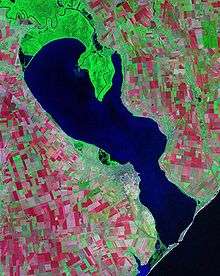Liman (landform)



Liman (Лиман) is a Hellenized Russian adaptation of the Medieval Greek λιμένας (limenas) meaning bay or port. The term is usually used in place of the more universal delta, with its implication of landform, to describe wet estuaries in the Black Sea and the Sea of Azov. A synonymous term guba (губа) is used in Russian sources for estuaries of the Russian shores in the north. A liman forms at the widening mouth of a river, where flow is blocked by a bar of sediments. A liman can be maritime (the bar being created by the current of a sea) or fluvial (the bar being created by the flow of a bigger river at the confluence).
Water in a liman is brackish with a variable salinity: during periods of low fresh-water intake it may become significantly more saline as a result of evaporation and inflow of sea water.
Such features are found in places with low tidal range, for example along the western and northern coast of the Black Sea, in the Baltic Sea (Vistula Lagoon, the Curonian Lagoon), as well as along the lowest part of the Danube. Examples of limans include Lake Varna in Bulgaria, Lake Razelm in Romania, the Dniester Liman in Ukraine, the Anadyrskiy Liman in Siberia and Amur Liman.
Etymology
English borrows the word from Russian лима́н (Russian pronunciation: [lʲɪˈman]), which originated in the Medieval Greek λιμένας meaning bay or port. The word was spread by Turks when they occupied the western and northern shore of the Black Sea, with the meaning of harbour and port. In Bulgarian, Romanian, Ukrainian and Russian the word defined the particular estuary, Dniester Liman.[1]
See also
References
| Look up liman in Wiktionary, the free dictionary. |
- ↑ "лимáн" Vasmer's Etymological Dictionary in Russian
| Wikimedia Commons has media related to Limans. |